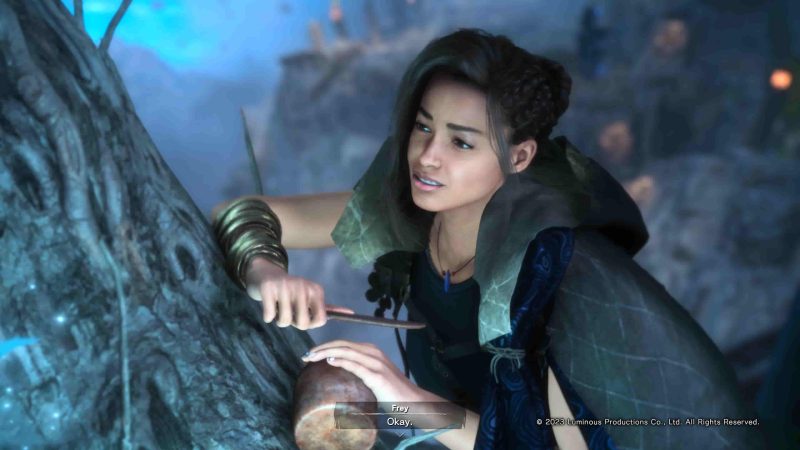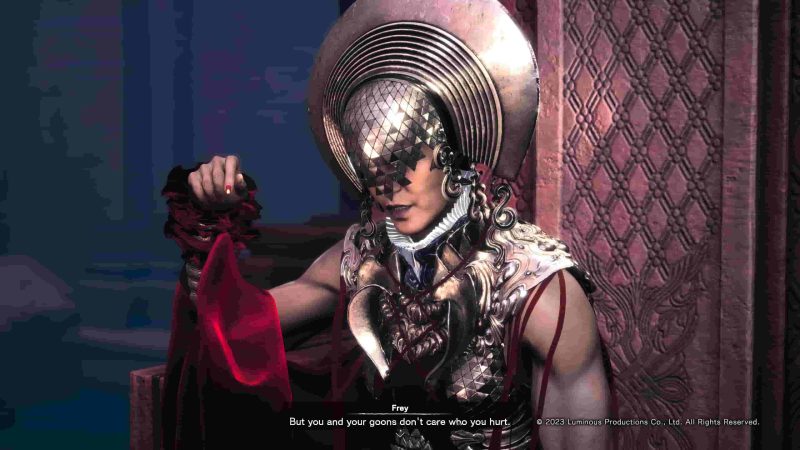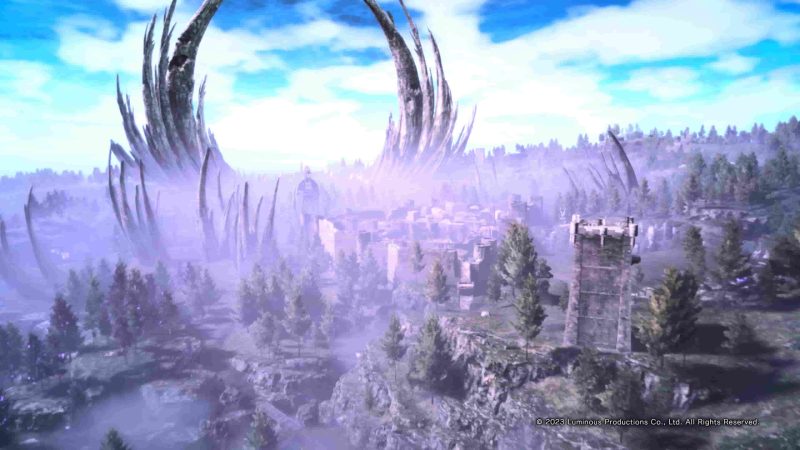Forspoken Review (PS5) – Much like I do with games I look forward to, I kept myself distant from any Forspoken coverage. I want my game experience as unaffected by the community and industry as possible.
Either way, I found myself facing the same package that everyone else did. While Forspoken has plenty of fundamental problems, the game itself has enough to bring you in, even if only for its short brevity.
Forspoken Review (PS5) – An Incomplete Product With Great Ideas And Heart
Frey Holland grew up all alone on the streets of New York City after being found in a dumpster. Naturally a cynic, she sees nothing but defeat and sadness everywhere she looks.
She lives in a shambled apartment, scrimping and saving every dollar she can so she can finally start over somewhere else. However, her prickly demeanor pisses off the wrong group of people, who set fire to her apartment, literally burning up her life savings with it.
While contemplating her limited choices, she happens upon a gold wrap in an abandoned pawn shop. In hopes to perhaps sell it, she grabs it only for it to bind itself to her and send her to an entirely different world.
She lands in Athia, an almost barren land corrupted by something called the Break that doesn’t seem to affect Frey at all. The remaining inhabitants ultimately plead for her aid. However, she stands reluctant, only motivated to get back to New York.
During your time in the game, you run around with Frey and her wrist-bound companion, Cuff. They do not like each other, and their constant banter enforces that. They clash culturally, morally, and linguistically, but they share one trait: blatant and imposing attitude.
Building A Protagonist
Frey absolutely does not want to help. All she wants is to return to New York. However, a sequence of things she ends up doing ultimately helps the people of Athia. Their hope grows in her, but she resists more and more as these synchronized events take place.
The team at Luminous Productions constructed a thoroughly flawed human being in Frey, and her character remains consistent from beginning to end, even as she develops.
Coupling her with Cuff is a tricky feat. Two big personalities spending a large amount of time together without them getting obnoxious demands a great deal of balance between letting them talk without talking too much.
This balance doesn’t always work, but there’s a realism to that. People are hard to deal with, especially within constrained situations of common interest. Apart from the repetitious open-world banter, their back-and-forth keeps things in perspective. Hell, I even laughed from time to time.
Do with this as you will, but I personally loved it. Here is an example of their backbiting after a successful fight:
Cuff: “That was a passable display.”
Frey: “You call that a compliment?.”
Cuff: “If you like.”
One final point I want to make is one from a writing mechanic standpoint: This game utilizes foreshadowing and parallelism well, both of which appeal to me in all mediums. Some things you see coming, and some things end up different enough to surprise. Regardless, the narrative structure forms a cohesive package from a rubric standpoint.
In Search of Tanta
The overarching goal is for you to seek out the four deified figures of Athia, the Tanta, and stop them. Once rulers of the realm, they succumbed to the Break and went mad, destroying everything they once held dear.
In doing so, Frey hopes to find the power and knowledge needed to get back home.
Each one of the Tanta showcases its own set of elemental spells. Even better still, once you defeat them, you gain their spell list. Different enemies take more damage from certain elements, so you need to switch between the lists. If you don’t, you might as well beat on a wall with a newspaper for how long it’ll take you to win.
Apart from the fire element, your attacks lack much variety. The skills themselves are distinct and different from each other, but three of your four spell lists consist of range-only attacks.
Due to its uniqueness, the fire list feels more visceral. You use either fists, swords, or magma to beat down enemies. You fly around the field even more than you did before, and it feels nothing short of empowering.
Uniquely Your Game
Forspoken presents itself in such a way that it lets you make it what you want by how much you want to invest in it. It gives you guidance in general ways, such as basic combat mechanics and directions, but the nitty gritty remains in your efforts to find.
This approach creates an intangible reward of power as the player. When you try something new, it comes out much more grand than you thought and you say, “Holy hell, I just did that!” You get what you put into it, and it feels bad ass at time.
The same goes for the world and its lore. If you buzz through the game, you get just enough to keep up with the events in front of you. If you take the time to complete side quests and find hidden pieces of lore, the world and its people soon build into a tangible concept instead of a mere magical playground.
To boot, the labor of love the developers placed in the lore can far too easily be missed. If you don’t explore and interact with people, you miss the finer details that help cement the foundation the overarching story delivers.
Equally so, you can make Forspoken that very experience, if you wish. All the tools are there for you to fly around the map, laying waste to all Break-infested creatures and not worry about the narrative beats.
By the way, the enemy variety and aesthetics rock. Break creatures aside, seeing actual animals corrupted by the Break gives them a terrifying element that rides along with your familiarity.
Going back to the spell lists: While most narrative fights require one specific list, you can spend your free roam time using whenever you choose. Hell, if you want to beat that wall with a newspaper, you can do that too; easier difficulties help with this approach
In fact, the game lets you cater your combat experience to fit your needs and wants as well. With three difficulties, aim assist, and auto-dodge as available options, you can either dig deep and fight no holds barred on your own or let the game give you the freedom to look absolutely badass while attacking.
These options make accessibility quite inclusive. They bring empowerment to people who don’t get many options to experience games like this. That goes a long way for many gamers.
Looming Problems
Unfortunately, though, the speed of the game and the camera make manual aiming very hard to do, especially when waves of enemies are coming at you. Even though the game provides a white arrow around Frey when you get flanked, getting hit from behind still happens too much.
This brings things into another problem: the game’s actual difficulty. Far too many games translate difficulty into quantity, aka amount of enemies on-screen. Instead of making fights hard, the game just throws bodies at you.
Forspoken does this. While most of your spells do splash damage and seeing all those numbers and bodies flying around is fun, it leaves the one-on-one fights, particularly boss fights, mostly one-dimensional.
Then there’s the world itself. While absolutely gorgeous, it stretches out far too much. It gives you the occasional opportunity to parkour in cool situations, like crossing a ravine by jumping between floating rocks to get to the other side. That was one of my favorite random moments in the world.
Most of the time, though, you just sprint from beat to beat, picking up collectibles and fighting enemies. Side quests only exist in the main city due to the Break. Narratively, this makes perfect sense, but it leaves the game world lacking true interactivity.
Again, the world is nothing short of stunning. It just needs much more in it to authentically experience outside of collectibles. Considering the base story only lasts 15 hours or so, having a significant chunk of that time dedicated to traversing a blank canvas brings a lot of attention to the world’s emptiness.
Finally, the supporting characters lack the kind of subtle details granted to Frey. While still a bit muted, you see specific facial expressions and mouth movement that matches the mood she expressed. NPCs present much more stiffness. Brows may tighten and mouths move a little more, but they lack true minute animation.
This comes as a major shame because the voice work for the supporting cast carries their presentation. Even the cameo from Debra Wilson feels underwhelming because of this.
Making Due With What You Get
To be frank, Forspoken doesn’t live up to its AAA moniker due to simplistic combat, an almost barren world, limited NPC animation, and lack of genuine gameplay variety all rear their head eventually.
Equally so, the story and characters presented here deliver enough to bring any RPG fan along for the ride, even if the ride itself favors spectacle over variety. It’s not for everyone, and I can’t say that the hefty price tag helps the game at all.
Still, if the timing is right and you truly know what you’re getting into, Forspoken does enough to mitigate its issues if you allow the game to work its magic on you.
Forspoken is now available on PS5.
Review code generously provided by publisher.










